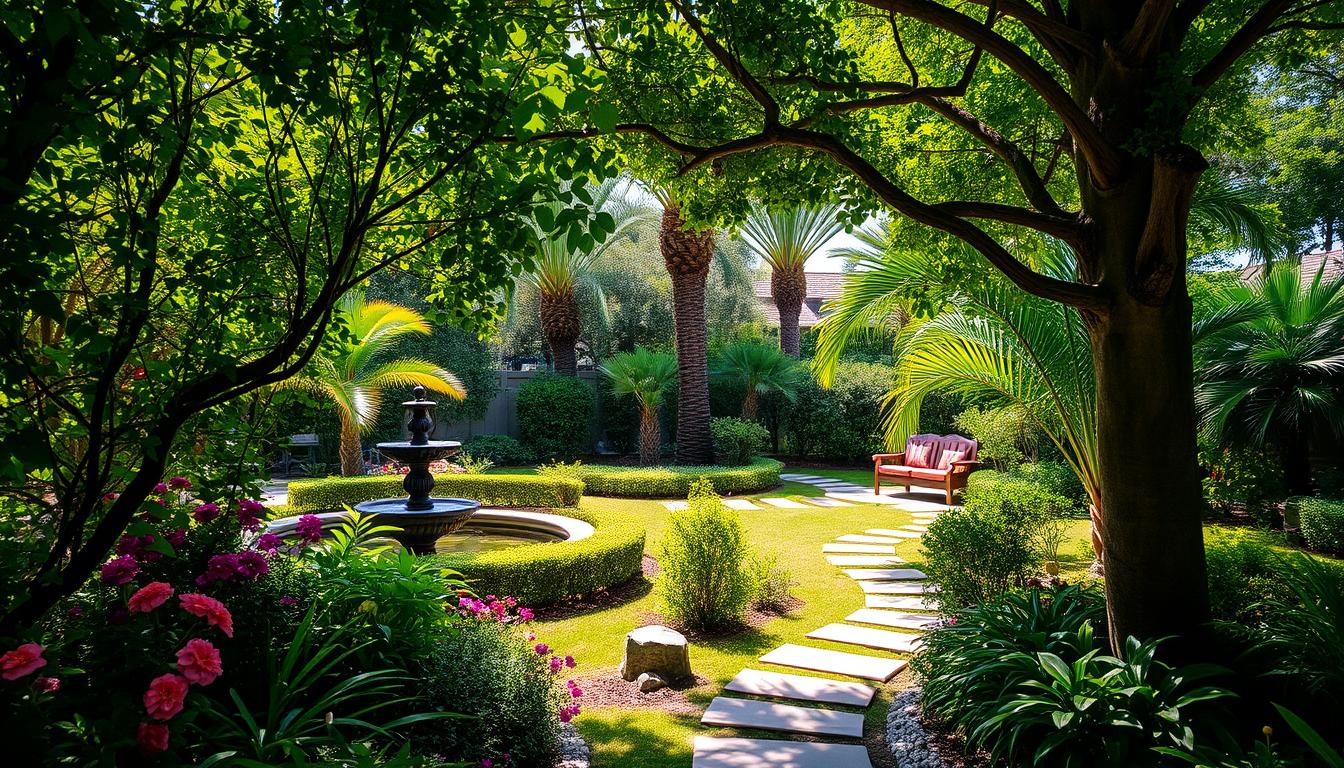Creating a thriving outdoor space is easier than you think. Whether you’re a beginner or have years of experience, anyone can transform their area into a green haven. From fresh produce to mental wellness, the benefits are endless. Plus, it’s a great way to make a positive environmental impact.
Starting small is key. Raised beds are an excellent option for those who want to grow their own food without the hassle. They’re easier to maintain and perfect for optimizing space. Lori, a seasoned gardener, started with a 10’x10′ plot and now manages multiple growing areas. Her journey proves that with the right tips, success is within reach.
This guide covers 17 actionable tips to help you get started. You’ll learn about soil health, space optimization, and seasonal planning. Whether you want to grow vegetables, herbs, or flowers, these strategies will set you up for success. Ready to create your own lush oasis? Let’s dive in!
Key Takeaways
- Backyard gardening is achievable for all skill levels.
- Fresh produce and mental wellness are key benefits.
- Raised beds make maintenance easier for beginners.
- Soil health and space optimization are crucial for success.
- Seasonal planning ensures year-round growth.
1. Introduction to Gardening Backyard
Many people dream of a lush outdoor space but hesitate to begin. Over 72% of aspiring gardeners delay starting because they feel overwhelmed. The good news? You don’t need a huge area or years of experience to create a thriving garden.
Lori, a seasoned gardener, started with a simple 10’x10′ plot. Her success story proves that starting small can lead to big results. She follows the “constraint is success” philosophy, focusing on a manageable number of plants each year. This approach helps beginners avoid feeling swamped.

One practical tip is to use 3′ wide raised beds with 3′ pathways. This setup optimizes space and makes maintenance easier. Keeping a garden journal is another smart move. It helps track progress, note successes, and learn from challenges.
For those who want to grow both beauty and food, edible landscaping is a great idea. Combine vegetables and flowers to create a functional yet stunning space. Don’t forget to check your USDA hardiness zone to choose plants that thrive in your area.
Renters or those with limited space can still get started with mobile options. Containers and community plots are excellent alternatives. Whether you’re a beginner or have years of experience, these strategies make it easy to begin your garden journey.
2. Choosing the Perfect Location for Your Garden
Finding the right spot for your outdoor project is the first step to success. The location you select impacts everything from plant health to maintenance ease. Start by evaluating your space for sunlight and water accessibility. These two factors are critical for thriving plants.

Sunlight Requirements
Most vegetables need at least 8 hours of direct sunlight daily. Use smartphone apps to map sunlight patterns in your area. These tools help identify the sunniest spots. For shaded areas, consider leafy greens or mushrooms. They thrive with less light.
Water Accessibility
Easy access to water is essential. Drip irrigation systems reduce water use by 30-50%. They’re efficient and eco-friendly. Install rain barrels to conserve water. A simple percolation test can assess soil drainage. This ensures your plants get the moisture they need.
| Factor | Tips |
|---|---|
| Sunlight | Use sun mapping apps, plant leafy greens in shade |
| Water | Install drip irrigation, use rain barrels |
| Soil | Test drainage with a percolation test |
Windbreaks like sunflowers or lattice panels protect plants from strong winds. Mobile options like wheeled planters or fabric grow bags are perfect for renters. As Lori says, “Your current space is the ideal size to start.” With these tips, you’ll find the perfect spot for your garden.
3. Preparing the Soil for Success
Healthy soil is the foundation of a thriving garden. Without proper preparation, even the best plants struggle to grow. The good news? With a few simple steps, you can create nutrient-rich soil that supports vibrant growth.
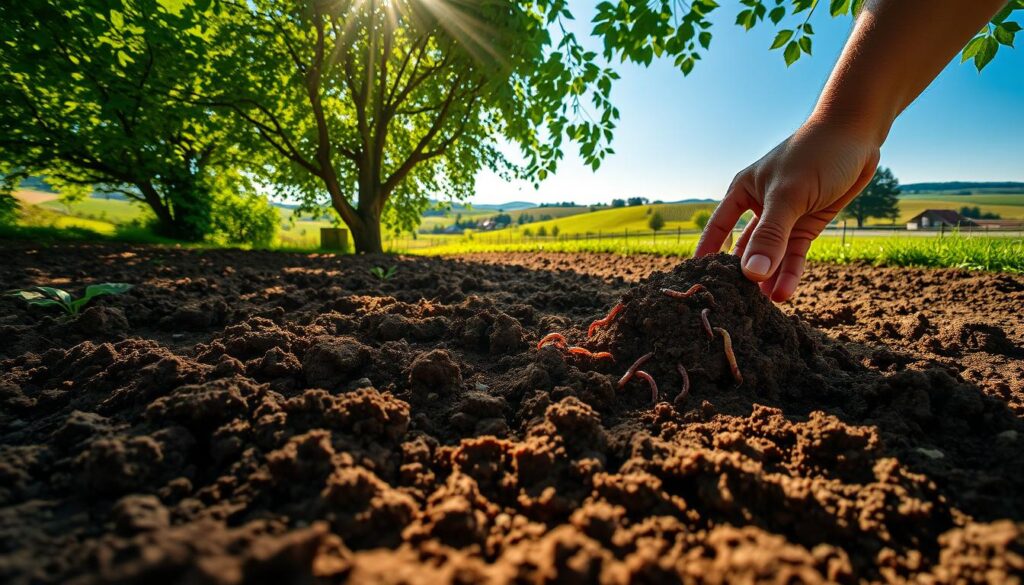
3.1 Adding Organic Matter
Adding organic matter is one of the best ways to improve your soil. It increases water retention by 20% and provides essential nutrients. Compost is a great option, especially when layered with a 5:1 carbon-to-nitrogen ratio.
For urban spaces, try the layer composting method. Worm towers are another excellent choice for vermicomposting. Cover crops like clover can also fix nitrogen naturally, enriching your soil over time.
3.2 Soil Testing and Amendments
Testing your soil is crucial for understanding its needs. Look at N-P-K ratios to determine nutrient levels. DIY amendments like eggshells for calcium or banana peels for potassium are budget-friendly solutions.
For long-term fertility, consider hugelkultur beds. These raised garden beds use decomposing wood to create a nutrient-rich environment. Don’t forget to check local municipal compost programs for free resources.
By focusing on soil health, you’ll set the stage for a thriving vegetable garden. Whether you’re using raised garden beds or traditional plots, these tips ensure your plants have the best start.
4. Maximizing Space with Raised Beds
Raised beds are a game-changer for optimizing outdoor spaces. They allow you to grow more in less area while making maintenance easier. Whether you’re working with a small plot or a larger area, these structures can transform your growing experience.

Building Raised Beds
Start by choosing the right materials. Cedar is a popular option for its durability, while composite materials offer longevity. For a budget-friendly approach, consider cinder blocks or repurposed pallets. A 4’x8′ bed size is ideal, increasing yield by 40% compared to traditional rows.
Accessibility is key. Ensure pathways are at least 3′ wide for easy movement. For wheelchair users, consider lower bed heights and wider paths. Winterizing your beds with cold frames or cloches can extend the growing season.
Plant Spacing and Layout
Proper spacing ensures healthy growth. Use square foot gardening charts to maximize efficiency. For example, plant one tomato per square foot or nine carrots in the same space. Vertical integration, like trellises for cucumbers or beans, saves even more space.
Companion planting is another smart strategy. Pair tomatoes with basil or carrots with onions to boost growth and deter pests. Succession planting schedules keep your beds productive year-round. For inspiration, check out Three Acre Farm’s 3’x12′ bed layout.
- Cost-effective materials: cinder blocks, repurposed pallets
- Vertical integration: trellises for cucumbers and beans
- Companion planting pairs: tomatoes + basil, carrots + onions
- Accessibility features for wheelchair users
- Winterizing beds with cold frames or cloches
5. Selecting the Right Plants for Your Garden
Choosing the right plants can make or break your garden’s success. Whether you’re growing vegetables, flowers, or a mix of both, the key is to match your selections to your space and skill level. Start with beginner-friendly options to build confidence, then explore advanced techniques like companion planting.

5.1 Beginner-Friendly Plants
If you’re new to gardening, start with foolproof options. Cherry tomatoes, zucchini, and radishes are easy to grow and yield quick results. These vegetables are forgiving and require minimal maintenance, making them perfect for beginners.
For flowers, consider sunflowers, lavender, and bee balm. These pollinator powerhouses attract bees and butterflies, boosting your garden’s ecosystem. Zinnias, for example, increase pollinator visits by 60%, adding both beauty and function to your space.
Lori, a seasoned gardener, recommends these “gateway plants” for new enthusiasts. “They’re low-stress and high-reward,” she says. Starting small with these options helps you build skills and confidence.
5.2 Companion Planting
Companion planting is a smart way to maximize your garden’s potential. Pairing certain plants together can improve growth, deter pests, and enhance flavor. For example, tomatoes thrive alongside basil, while carrots grow well with onions.
Herbs like marigolds, nasturtiums, and chrysanthemums are natural pest repellents. They protect your vegetables without the need for chemicals. This method also saves space, making it ideal for smaller gardens.
When planning your layout, consider bush beans vs pole beans. Bush beans require less space, while pole beans grow vertically, saving ground area. Use seed tape for precise planting or direct sow for simplicity. Whether you choose heirloom or hybrid seeds, each has its pros and cons. Heirlooms offer unique flavors, while hybrids are often more disease-resistant.
By combining beginner-friendly plants with companion planting strategies, you’ll create a thriving garden that’s both productive and beautiful. Want to grow your skills? Start with these tips and watch your garden flourish.
6. Efficient Watering Techniques
Watering your plants efficiently can save time and resources. Proper techniques ensure your plants thrive while conserving water. From drip irrigation to mulching, these methods are easy to implement and highly effective.
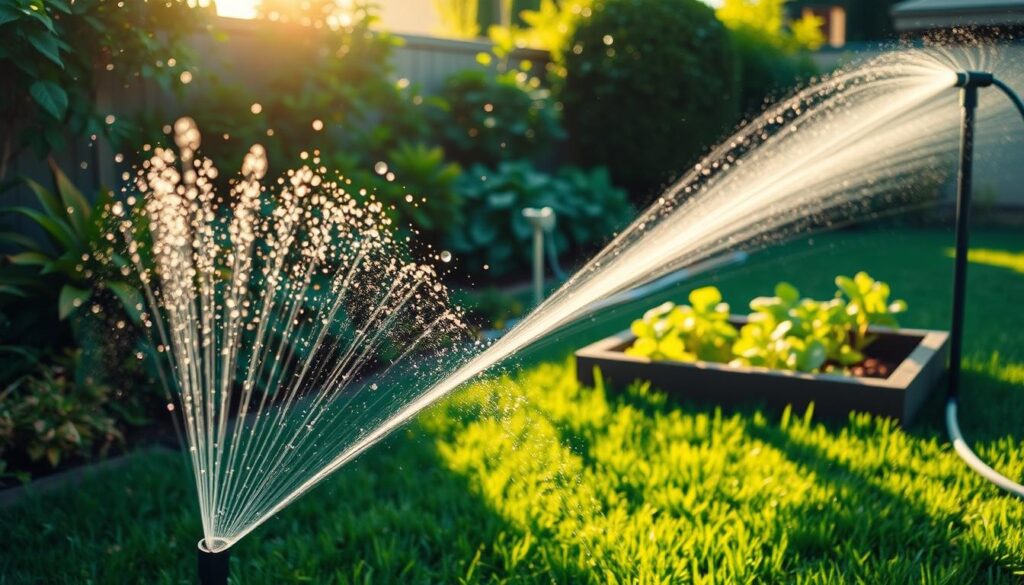
6.1 Drip Irrigation Systems
Drip irrigation is a game-changer for efficient watering. It delivers water directly to plant roots, reducing waste by up to 50%. Soaker hoses, a type of drip system, save 90 gallons weekly compared to sprinklers.
For a budget-friendly option, create a DIY drip system using recycled materials. Install rain sensors for automated systems that adjust to the season. Lori’s “finger test” is a simple way to check soil moisture. Stick your finger 2 inches into the soil—if it’s dry, it’s time to water.
6.2 Mulching for Moisture Retention
Mulch is a powerful tool for retaining moisture. It reduces evaporation by 70%, keeping soil hydrated longer. Organic options like straw or wood chips are excellent choices. Straw is lightweight and easy to spread, while wood chips last longer.
Living mulch, such as creeping thyme or sweet potato vines, adds beauty and function. Edible mulches like strawberry plants or pumpkin vines are both practical and productive. For arid climates, xeric gardening techniques can further conserve water.
| Mulch Type | Benefits |
|---|---|
| Straw | Lightweight, easy to spread |
| Wood Chips | Long-lasting, durable |
| Living Mulch | Adds beauty, retains moisture |
| Edible Mulch | Productive, functional |
By combining drip irrigation and mulching, you’ll optimize water use and keep your plants healthy. These strategies are simple, effective, and perfect for any outdoor space.
7. Pest and Disease Management
Keeping your plants healthy doesn’t have to be a challenge. With the right strategies, you can protect your garden from pests and diseases while staying eco-friendly. Whether you’re growing vegetables or flowers, these tips will help you maintain a thriving space.
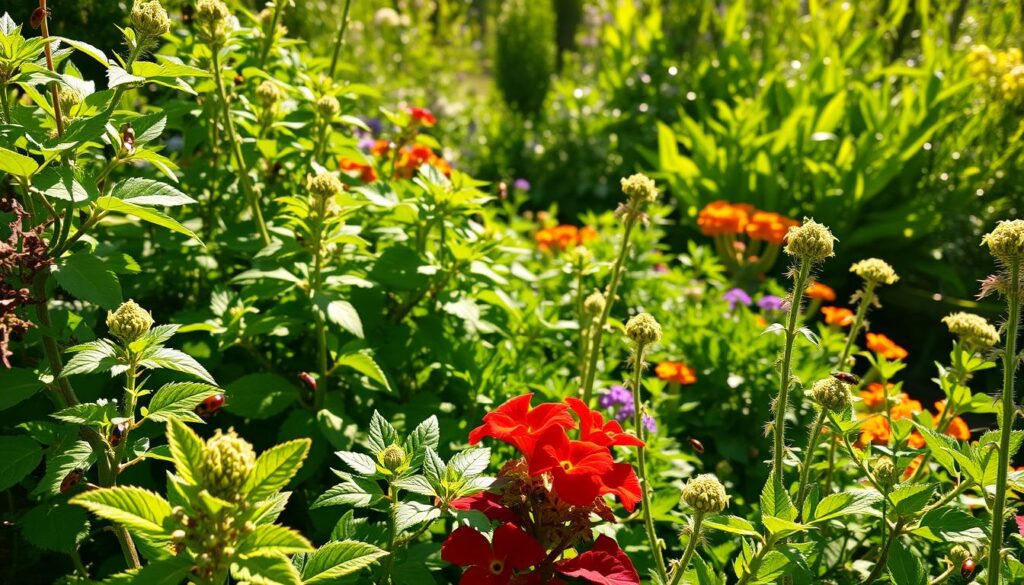
7.1 Organic Pest Control
Organic methods are a safe and effective way to manage pests. Neem oil, for example, works against over 200 types of insects. It’s a natural solution that won’t harm your plants or the environment.
For slugs, beer traps are a simple yet powerful tool. Place shallow containers filled with beer near your plants. Slugs are attracted to the yeast and will drown in the liquid. Garlic spray is another great option for aphids. Just mix crushed garlic with water and spray it on affected areas.
- Beneficial insect hotels attract ladybugs and lacewings, which eat harmful pests.
- Row covers timed correctly can protect plants like cabbage from moths.
- Companion planting, such as alliums with carrots, deters pests naturally.
7.2 Disease Prevention
Preventing diseases starts with healthy practices. Crop rotation is a proven method. By changing the location of your vegetable plants every three years, you break pest and disease cycles. This keeps your soil and plants healthier.
Solarization is another effective technique. Cover your soil with clear plastic during hot months to kill soil-borne pathogens. For added protection, choose disease-resistant plant varieties and note them in your garden journal.
Lori’s “sacrificial plant” strategy is a clever way to protect your garden. Plant a few extra vegetables to attract pests away from your main crops. This ensures your primary plants stay healthy and productive.
8. Seasonal Gardening Tips
Seasonal changes bring new opportunities to grow and maintain your outdoor space. Whether it’s spring planting or fall maintenance, adapting your strategies ensures your plants thrive all year long. Let’s explore how to make the most of each season.
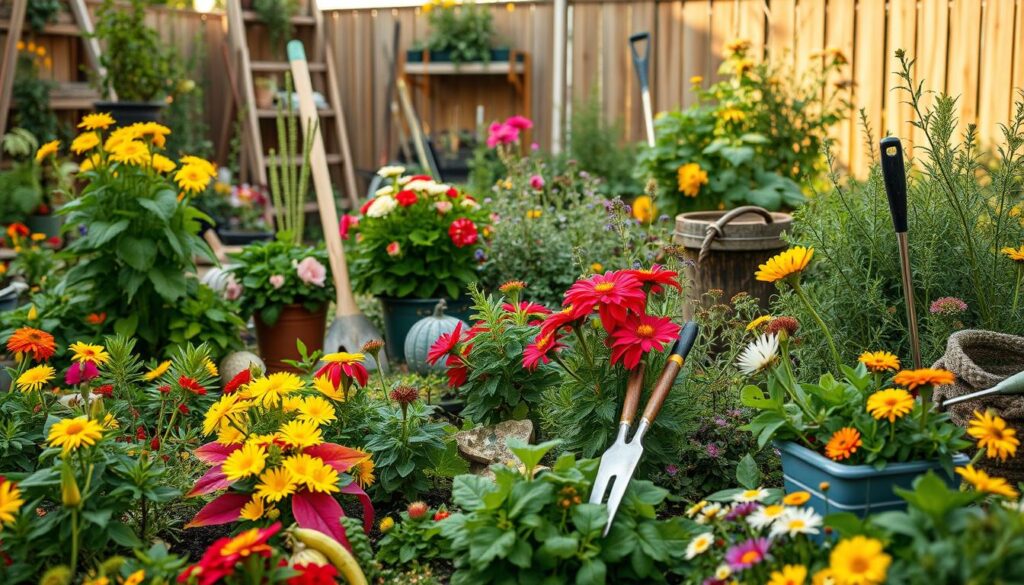
Spring Planting Guide
Spring is the perfect time to prepare your soil and start planting. Begin with soil prep—debate between broadforking or tilling based on your needs. Broadforks aerate the soil without disrupting its structure, while tillers work faster for larger areas.
For heat-loving transplants, use hardening techniques. Gradually expose seedlings to outdoor conditions over a course of 7-10 days. This helps them adjust to temperature changes and reduces shock.
Succession planting is another smart strategy. Plant crops like lettuce or radishes every two weeks for a continuous harvest. Use frost date calculators by ZIP code to determine the best time to start.
- Broadfork vs tiller: Choose based on soil type and garden size.
- Hardening transplants: Gradual exposure prevents shock.
- Succession planting: 2-week intervals for continuous harvests.
Fall Garden Maintenance
Fall is the time to prepare your garden for winter and set the stage for spring. Overwintering kale, for example, yields sweeter leaves after a frost. Plant cover crops like winter rye or crimson clover to protect and enrich your soil.
Extend your growing season with low tunnels or thermal mass techniques. These methods trap heat, allowing you to grow cold-hardy vegetables longer. Don’t forget to plant bulbs for spring blooms—tulips and daffodils add early color to your space.
Lori’s “putting the garden to bed” checklist includes cleaning tools, removing debris, and saving seeds from tomatoes and beans. These steps ensure a smooth transition into the next growing year.
- Cover crops: Winter rye and crimson clover enrich soil.
- Season extension: Low tunnels and thermal mass techniques.
- Bulb planting: Tulips and daffodils for spring blooms.
- Seed saving: Protocols for tomatoes and beans.
9. Conclusion: Start Your Gardening Backyard Journey Today
Transforming your outdoor area into a vibrant space is simpler than it seems. Start by focusing on the basics: healthy soil, smart spacing, and seasonal rhythms. Remember, progress is more important than perfection. Every small step brings you closer to your dream garden.
For inspiration, explore resources like Three Acre Farm’s community tools. Download a planting calendar or join a local co-op to connect with fellow enthusiasts. These steps make it easier to get started and stay motivated.
Take inspiration from success stories like Lori’s journey—from balcony herbs to a thriving market garden. Share your first-season photos online and celebrate your progress. Your future salad is waiting to be planted, so why wait? Begin today and watch your space flourish with life and color.

